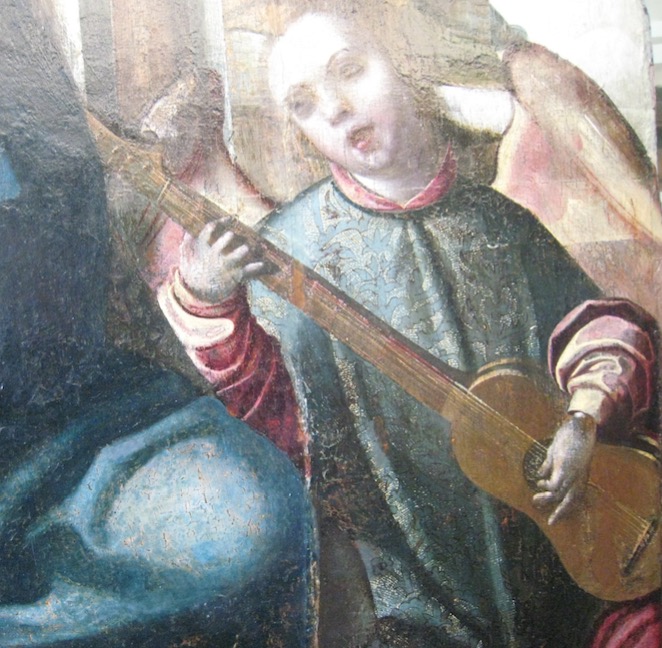Nossa Senhora das Neves com doador. (Virgin of the Snow with donor) Oil on wood by an anonymous painter, Portuguese school, 1540-1550. 1655/1660 x 1100 mm. Purchased at auction in Porto in 2000 by present owner Álvaro Sequeira Pinto, in Porto. Thought that it may have been part of a tryptich. Inspected by Sonia Duarte in 2010 and reported to be in good condition.
(1540-1550) - Porto, private collection
instrument: vihuela de mano | century: 16cent/2/mid | catalogue nº: 16-246

Artwork
Creator anon
Medium Artwork: Painting
Location
City Porto | Region Portugal | Old kingdom Portugal
Characteristics
| Body Waisted | Strings 6 courses | Neck Long | Pegbox Flat rectangle |
| Bridge Fixed | Frets Yes | Back Flat | Pegs Rear |
| Technique Plucked fingers thumb out |
Commentary
ARTWORK
Nossa Senhora das Neves com doador. (Virgin of the Snow with donor) Oil on wood by an anonymous painter, Portuguese school, 1540-1550. 1655/1660 x 1100 mm. Purchased at auction in Porto in 2000 by present owner Álvaro Sequeira Pinto, in Porto. Thought that it may have been part of a tryptich. Inspected by Sonia Duarte in 2010 and reported to be in good condition.
This panel represents the Virgin and Child flanked by an angel playing the vihuela and a young figure bent in genuflection and with folded hands. This could be the donor figure or a descendant of the donors would be represented on the wings of this panel. Defined by Vítor Serão as similar to the style of Diogo Contreiras, the background shows a Roman patrician’s home on the left, and the miracle of snow in August on the right. The presence of the vihuela is not common either.
INSTRUMENT
Compared to the viola da mano of the Misericordia de Abrantes, this one features a small sound box, six courses of strings (5 x 2; 1 x 1) - a quite long neck, surmounted by a pegbox with only nine pegs visible. The depiction appears accurate, although it is a left-handed instrument and the neck appears unusually long: it joins the body at about the 15th or 16th fret. The body of the instrument is small, but well proportioned and elegant in design. The soundhole is central and the bridge is quite close to the base of the soundboard. At the bridge it appears to be strung with 5 double courses and a single top string. It appears that the bridge may be slotted although it is impossible to be sure from the photographs at my disposal. The neck is fretted with what appear to be at least seven frets. The pegbox is simple with a single scallop on each side. The buttons of the pegs are partly visible as well as the tips of at least nine pegs. The entire pegbox cannot be seen. The instrument is clearly flat-backed.